Core i7 vs. Ryzen 4000: Which mobile CPU is fastest in Photoshop, Premiere and Lightroom
- 08 January, 2021 22:29

Just as gamers want their laptops to run Crysis, creators want their laptops to run Adobe Creative Cloud without a hitch. The choice was easy when Intel dominated mobile CPUs, but AMD’s Ryzen is a formidable up-and-comer now. Does it matter which one your laptop runs? We decided to run Photoshop, Lightroom, and Premiere through two benchmark suites to see which mobile CPU performs best.
What follows is a raft of charts, and they’re well worth perusing if you care about the nuances of application performance. But if you want to jump to the test that interests you most, or skip directly to the conclusion, use the handy hotlinks below.
- The benchmarks: Procyon and Pugetbench
- Our test laptops
- UL Procyon Photo Editing
- Procyon Premiere Performance
- Procyon Conclusion
- Pugetbench Adobe Photoshop Performance
- Pugetbench Lightroom Classic Performance
- Pugetbench Adobe Premiere Performance
- Adobe Laptop Performance Conclusion
The benchmarks: Procyon and Pugetbench
The first suite, and the “new kid” on the benchmark block, is UL’s Procyon (pronounced “PRO-see-on.”). Made by the same company that publishes the popular 3DMark, Procyon has two modules. The first is a Photo Editing module that runs Photoshop and Lightroom Classic through a set of scripts. The second module measures Premiere Pro performance. The benchmark doesn’t have a free version and is priced mostly for professionals.
The second benchmark is Puget System’s Puget Bench. Puget Systems is a Washington-based workstation builder that developed its own benchmark suite to help support its customers. The company offers a paid version and a free public version of Puget Bench; we used the latter.
It’s important to note that Procyon and Puget Bench are not synthetic tests. To run them, you need to have the Adobe applications installed. Both benchmark suites then run the applications through a scripted set of tests.
Our test laptops
The laptops we used for our tests were chosen to represent a variety of CPUs, and both discrete and integrated graphics:
- MSI’s Prestige 14 Evo is equipped with a 4-core, 11th-gen Core i7-1185G7 with Iris Xe graphics, 16GB of LPDDR4X/4267 memory, a 512GB PCIe Gen 4 SSD, and a 14-inch FHD screen. It weighs 2.7 pounds.
- MSI’s older Prestige 14 is equipped with a 6-core, 10th-gen Core i7-10710U, GeForce GTX 1650 Max-Q graphics, 16GB of LPDDR3/2133 memory, a 1TB PCIe 3.0 SSD, and a 14-inch 4K screen. It weighs 2.8 pounds.
- Lenovo’s Yoga Slim 7 has an 8-core Ryzen 4800U with Radeon graphics, 16GB of LPDDR4X/4267 memory, a 512GB PCIe 3.0 SSD, a 14-inch FHD, and lap weight of 3.1 pounds.
- The Asus ROG Zephyrus G14 includes an 8-core Ryzen 9 4900HS (sometimes mistyped as ‘4800HS’ in the charts that follow), GeForce RTX 2060 Max-Q graphics, 16GB of DDR4/3200 memory, a 1TB PCIe 3.0 SSD, a 14-inch FHD screen, and a weight of 3.6 pounds.
- The Acer Predator Triton 500 with a 6-core 10th-gen Core i7-10750H CPU, GeForce RTX 2080 Super Max-Q graphics, 32GB of DDR4/3200 memory, a 1TB PCIe 3.0 SSD, and a 15.6-inch 300Hz FHD screen. It weighs 4.6 pounds.
This selection gives us a nice mix of AMD and Intel CPUs, as well as three performance levels of Nvidia’s GeForce cards. It does make it a little hard to figure what exactly is driving any performance changes, but we can make some educated guesses. Normally we wouldn’t pit a 4.6-pound laptop with Nvidia’s most powerful GPU against a 2.7-pound laptop with integrated graphics, but in this case we want to see just what you get in exchange for the extra weight.
It’s also important to note that there is no real ‘right answer’ when you’re trying to determine performance based on applications as vast as Adobe’s suite. What you do in Photoshop, Lightroom or Premiere may not be what someone else does in those apps—and may yield different results. Benchmarks help us compare consistently, but your mileage will vary.
UL Procyon Photo Editing
The Procyon image editing module rolls up both Photoshop and Lightroom results into the same overall score. The entire test takes about 20 minutes to run.
The laptops with AMD CPUs are shown as a grouping of red bars, above a grouping of Intel laptops in blue bars. Some laptops have multiple bars to show performance at different CPU settings. In all cases, a longer bar indicates higher performance.
Looking at the results, we can see the MSI Prestige 14 Evo and its Core i7-1185G7 leads among the smaller and lighter laptops, beating both the prior-generation MSI Prestige 14 with 10th-gen Core i7-10710U and GeForce GTX 1650 Max-Q, and the thin-and-light Lenovo Yoga Slim 7 laptop with Ryzen 7 4800U.
The other trend we see from Procyon’s Photo Editing test is the importance of the GPU. Both the Asus ROG Zephyrus G14 and the Acer Predator Triton 500 likely get a very nice boost due to their GeForce graphics.
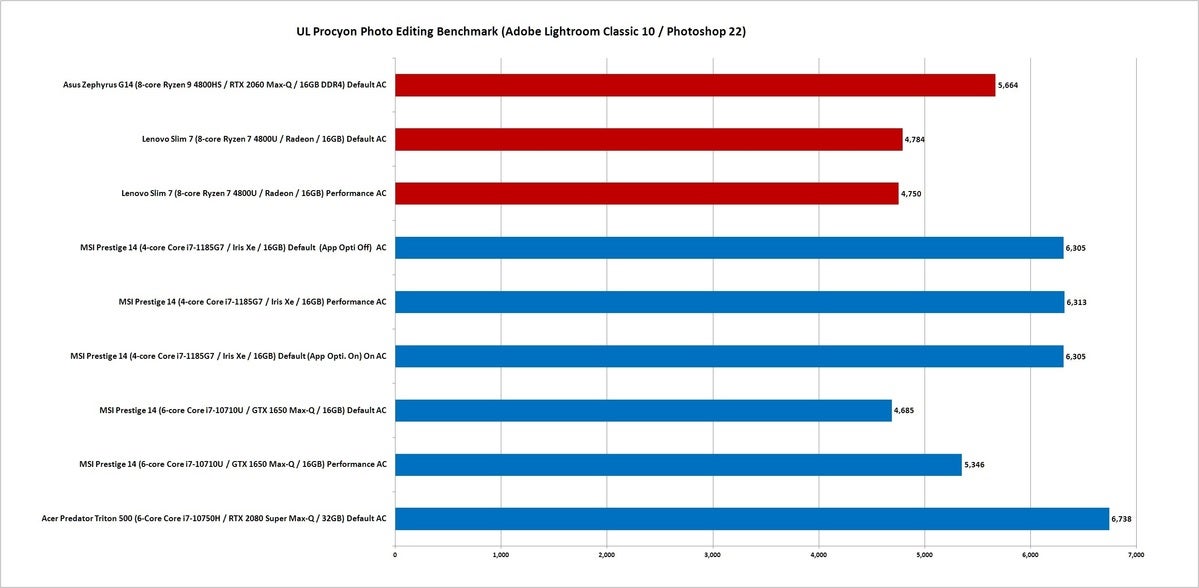 IDG
IDGThe chart below is broken into two categories: batch processing (red bar), which is performed all in Lightroom, and image retouching (blue bar), which is performed all in Photoshop.
The larger Acer Predator Triton 500 gaming laptop with its fast GPU leads here. The 11th-gen Tiger Lake MSI Prestige 14 Evo laptop has a decent advantage against both the older MSI Prestige 14 and the Lenovo Yoga Slim 7, and it can even outperform the Ryzen 9 4900HS and GeForce RTX 2060 Max-Q in the Asus ROG Zephyrus G14.
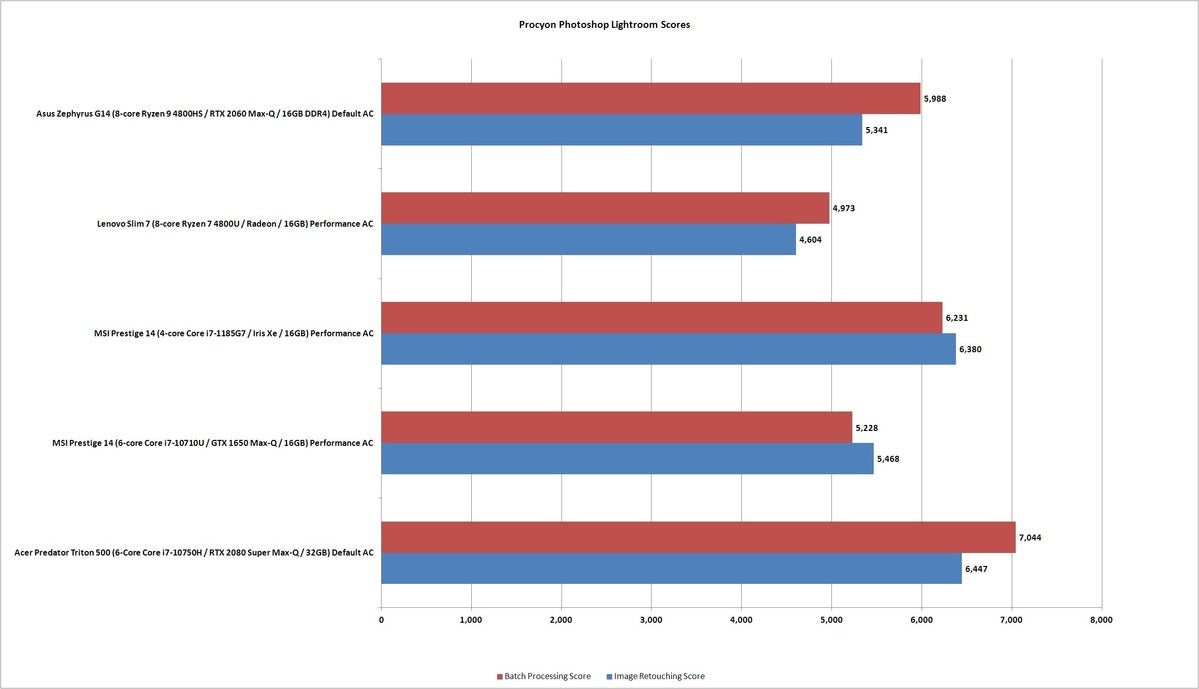 IDG
IDGOne thing we don’t know is whether the PCIe 4.0 SSD in the MSI Prestige 14 Evo bears some responsibility for the performance. Our gut says drive speed has rarely been a bottleneck, but storage could very much be helping the Tiger Lake laptop. IDG
Procyon Premiere Performance
We’ll finish off Procyon results with a look at its video test. Procyon tasks Premiere with exporting four files: Two are H.264 using the YouTube preset with Maximum Render quality, and two use H.265 and export to a UHD 4K resolution file, again with maximum render quality. The source file is a 4K video with lumetric color and noise correction applied to the clips. Other clips use the filter twirl, Gaussian blur, cross dissolve and motion applied, as well as crop, color balance, fast blur, sharpen.
If you look only at this chart (which includes running smaller laptops using their available default and performance cooling settings), you know the laptops with discrete graphics win, with the Acer Predator Triton 500’s GeForce RTX 2080 Super in first and the Asus ROG Zephyrus G14’s GeForce RTX 2060 in second place. Surprisingly, the GeForce GTX 1650 doesn’t hand the Prestige MSI 14 the win you’d expect. The MSI Prestige 14 Evo’s 11th-gen Tiger Lake with only 4 cores surprisingly bests the Lenovo Yoga Slim 7 with an 8-core Ryzen 7 4800U inside of it.
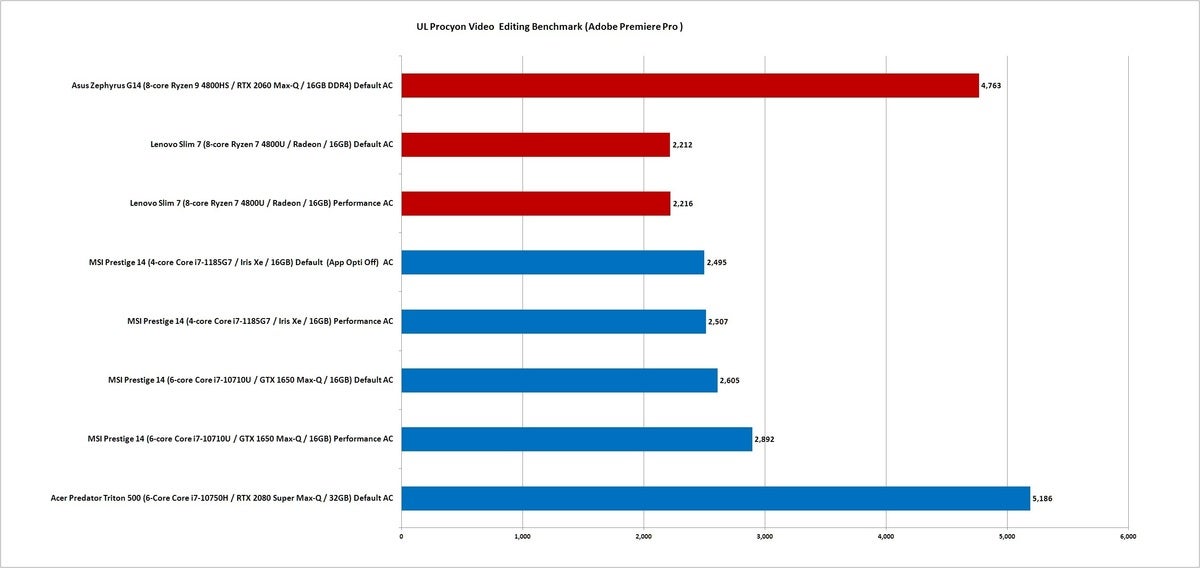 IDG
IDG
Procyon’s script for Adobe Premiere actually hands the 8-core Ryzen 7 4800U the L.
There’s a bit more to Procyon’s story. As we said above, the clips have various effects filters applied and also are broken up in two sections. One is made to be accelerated by the graphics cores—discrete or integrated, we suspect—as well as what looks to be conventional CPU encoding.
For the GPU encodes, those with the fastest lead the way. The laptops with GeForce RTX 2080 Super, GeForce RTX 2060, and GeForce GTX 1650 slide into a neat 1, 2, 3 sequence. You can see the results in the purple and red bars below (shorter bars are better, as the scores indicate how long it took to encode the videos).
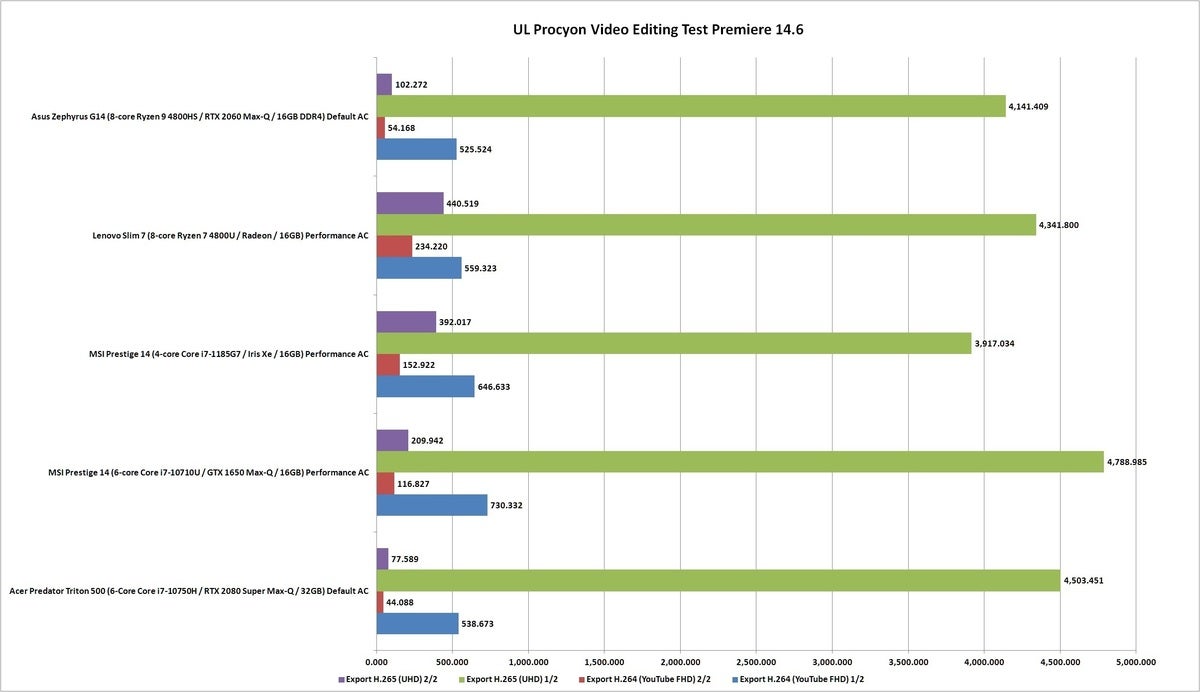 IDG
IDGIn the two CPU-heavy exports in green and blue, the two 8-core Ryzen chips actually do quite well. Looking at the blue bar for the H.264 export, the Asus ROG Zephyrus 14’s Ryzen 9 4900HS crosses the finish line first, closely followed by Acer Predator Triton 500 with the 6-core Core i7-10750H and the Lenovo Yoga Slim 7’s 8-core Ryzen 7 4800U. The MSI Prestige 14 Evo’s 4-core, 11th-gen Tiger Lake, and its predecessor Prestige 14’s 6-core, 10th-gen Comet Lake U, take up the rear.
That 1080p video is a fairly short run, though. Exporting to the much more strenuous H.265 codec at 4K (green bar) takes our encode from about 10 to about 72 minutes. The surprise winner for that H.265 encode is the MSI Prestige 14 Evo’s 4-core 11th Gen Core i7-1185G7 which etches a solid win over both laptops with 8-core Ryzen 4000 CPUs. Both of the older 14nm 10th-gen CPUs come in last, but not by much, which makes us think the CPU-based visual effects Premiere applies to the videos are an important factor here. It’s also why, frankly, we think the 11th-gen Tiger Lake CPU does as well as it does.
Procyon Conclusion
Looking at Procyon in totality, it’s clear that having a fast GPU supported by Adobe products helps—sometimes a lot. We’d also say that while AMD’s Ryzen 4000 can outperform Intel’s 11th-gen Tiger Lake, it doesn’t always do so where you’d expect it to. Photoshop, which still largely relies on lighter thread thread counts and burst clocks, continues to favors Tiger Lake.
If we had to declare a winner among the laptops without a graphics chip, we’d give it to Intel’s 11th-gen Tiger Lake. AMD’s Ryzen 4000 performs competently, but its strength continues to be in multi-core performance.
If we were buying a laptop based solely on Procyon, it would largely depend on how the work is split. If your work is mostly within Adobe apps, the 11th-gen Tiger Lake looks to be the overall winner. If, however, you also perform multi-threaded work such as 3D modelling, then the higher-core-count Ryzen 4000 can do both capably.
Keep reading to see how Pugetbench puts the laptops through their paces.
Page Break
Pugetbench Adobe Photoshop Performance
Pugetbench is made to test workstations, but the benchmark runs on regular PCs as well. What we like is that it doesn’t combine results, so you can better isolate just what matters to you.
Remember, there’s no real ‘right answer’ when you’re trying to determine performance based on applications as vast as Adobe’s suite. What you do in Photoshop, Lightroom or Premiere may not be what someone else does in those apps. Still, if the results we see here are similar to Procyon’s, we’ll feel better about making recommendations.
We’ll start with the overall score for Adobe Photoshop in Pugetbench, based on the latest version of the software. The red bars denote laptops with AMD CPUs, while the blue bars denote those with Intel chips. Longer bars are better. For the overall result, we include the various boost modes of the laptops, but for brevity’s sake we exclude them from the more granular tests that follow.
Based on what you see below, it’s clear the MSI Prestige 14 Evo and its 4-core 11th gen Core i7-1185G7 with Iris Xe graphics outshines the comparable Lenovo Yoga Slim 7 and its 8-core Ryzen 7 4800U. The fastest laptop of the bunch is actually the heaviest —the Acer Predator Triton 500 and its 6-core Core i7-10750H and GeForce RTX 2080 Super Max-Q GPU.
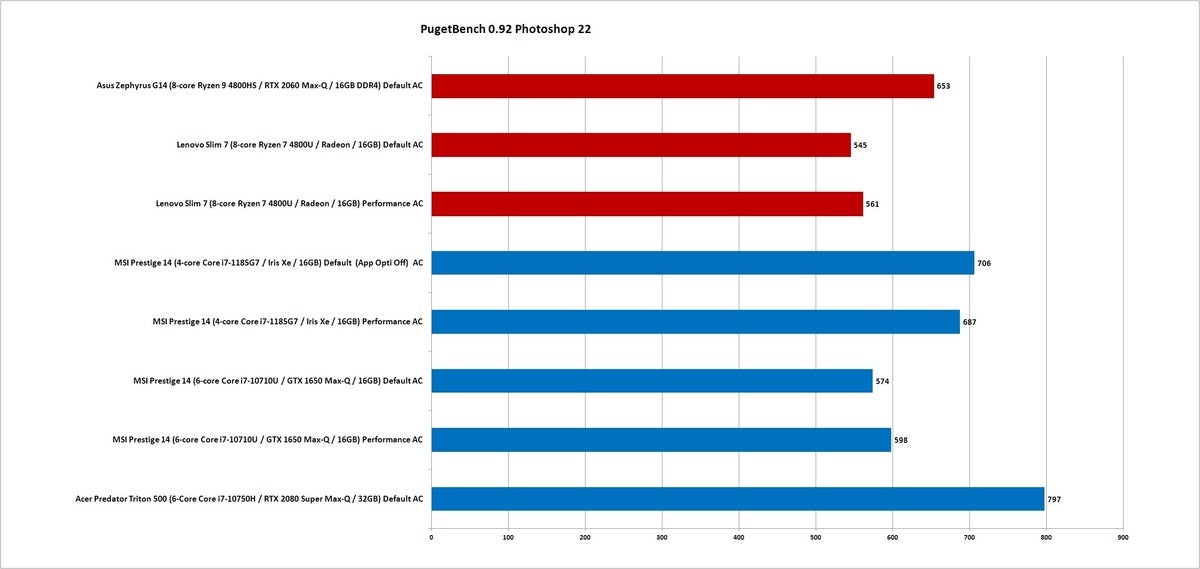 IDG
IDGDiving down a level, Pugetbench actually breaks down subscores based on Filter Score, General Score, and GPU score. The Acer Predator Triton 500 dominates with its older, but high-frequency Core i7-10750H and its GeForce RTX 2080 Super Max-Q. The Asus ROG Zephyrus G14 and its GeForce RTX 2060 Max-Q come in second. We expected the GeForce GTX 1650 Max-Q in the older MSI Prestige 14 to come in third, but it actually loses to the newer Prestige 14 Evo with its 11th gen Core i7-1185G7 and Iris Xe graphics. The Prestige 14 Evo’s 11th-gen Tiger Lake chip also comes in second in the filter score.
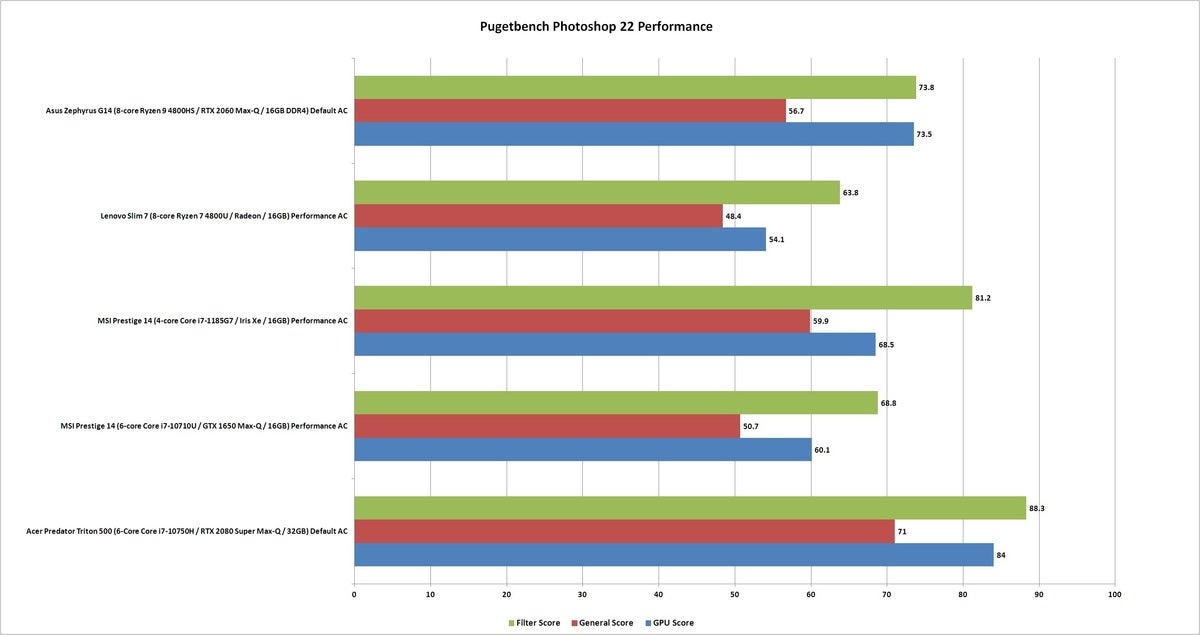 IDG
IDGPhotoshop Filters is one of the areas where performance will vary based on the filter or action you run, and what hardware you have. Puget Systems details out the exact actions below and whether they are GPU-based. For example, Field Blur, Iris Blur and Tilt Shirt Blur are GPU-accelerated. Adaptive Wide Angle and Content Aware Fill are not. We pulled out the best performance of the laptops in the filters and actions Pugetbench uses.
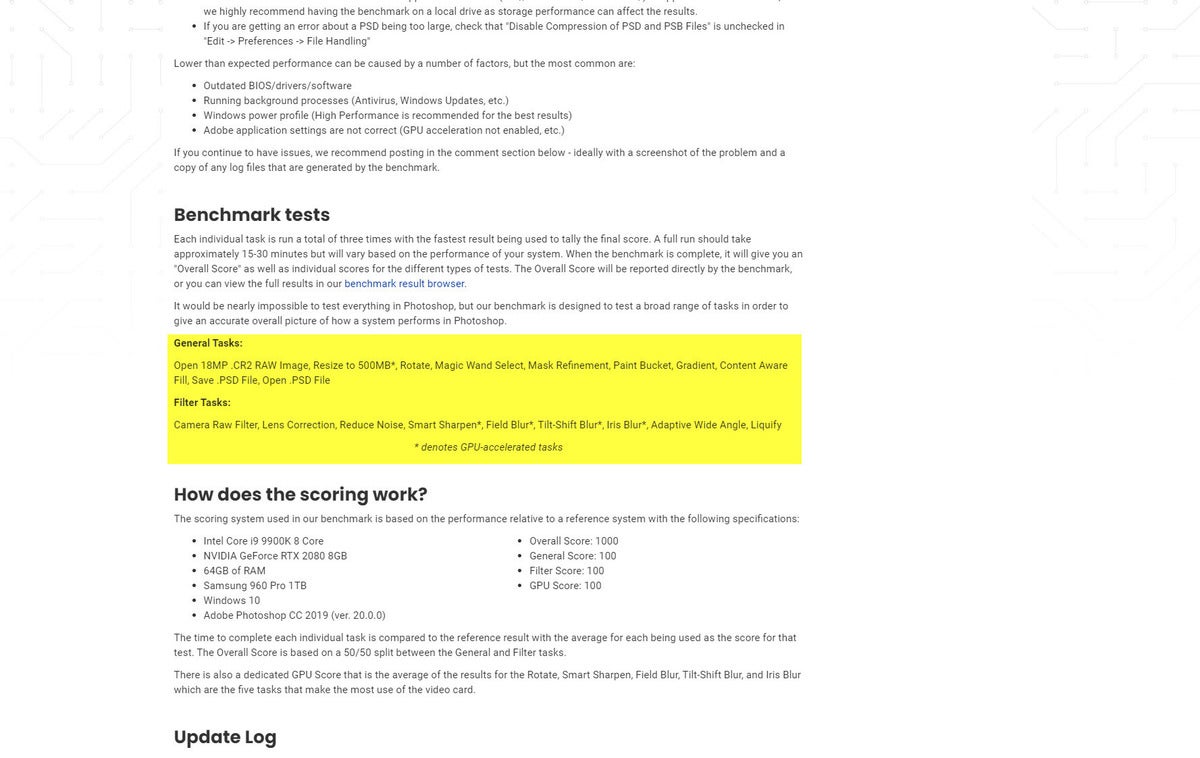 Puget Systems
Puget Systems Unlike the previous results, which are overall scores, the chart below shows you how long it took to complete the 16 tasks. A shorter bar indicates better performance here, and yes, you’ll need to blow up this chart and look at it close to see which filters you use the most.
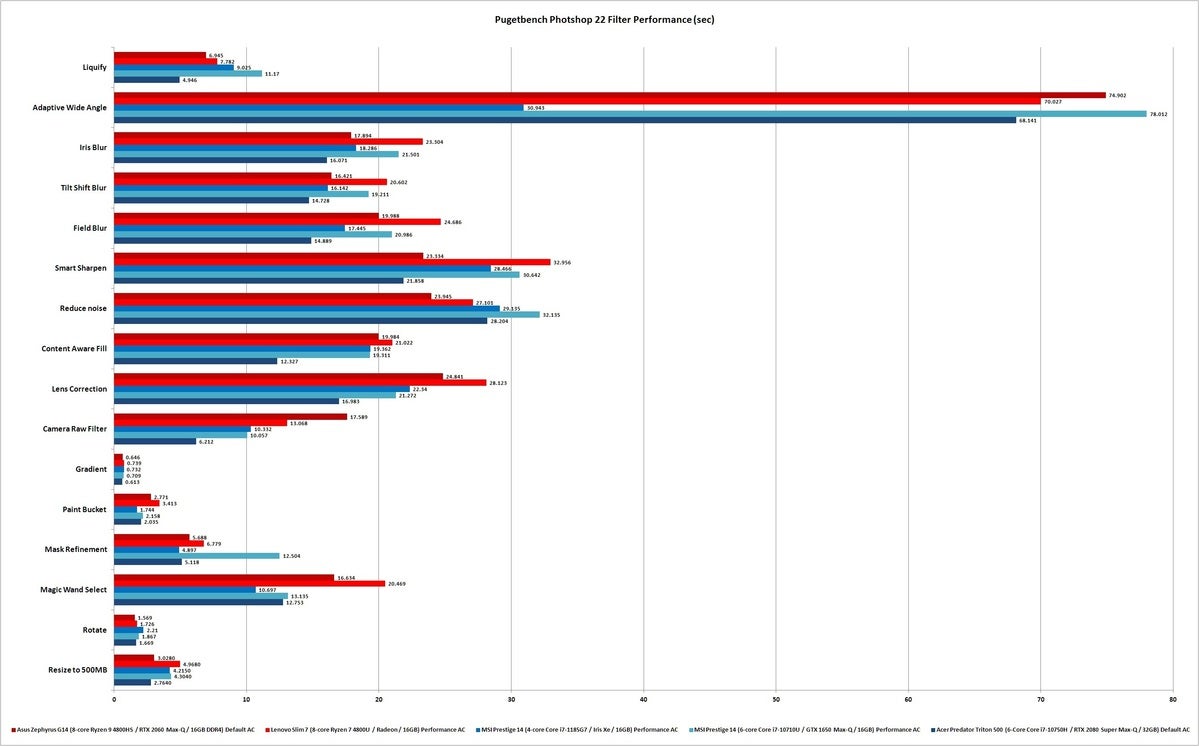 IDG
IDGSome things jump out at us from this buys chart. The first is Adaptive Wide Angle. This sophisticated task in Photoshop has likely been optimized to take advantage of some magic inside of Intel’s 11th-gen Tiger Lake chip, as the MSI Prestige 14 Evo takes less than half the time to run than even the Acer Predator Triton 500 and Asus ROG Zephyrus G14. The 11th-gen Tiger Lake also leads the way in Magic Wand Select, taking about half the time compared to the Lenovo Yoga Slim 7 and its Ryzen 7 4800U. In other tests, like Liquify and Reduce Noise, the Ryzen chips’ higher core counts prevail.
Oddly, while the fast RTX GPUs in the Acer Predator Triton 500 and Asus ROG Zephyrus G14 pulled some weight, the MSI Prestige 14’s GTX 1650 disappointed us—confusing given that it’s based off the same Turing cores as both RTX GPUs. It’s possible that Photoshop sometimes bypassed the discrete GPU for integrated graphics. It’s also possible that the older Prestige 14 was pushed too hard, causing it to throttle performance harshly.
The last Pugetbench Photoshop benchmark we show, File Performance, measures the time it takes to open a PSD file and also save a PSD file. Obviously, it’s a pretty large PSD file, taking about 14 seconds just to open the file, while the file save takes in excess of 100 seconds.
 IDG
IDGThe laptop with the best performance was the MSI Prestige 14 Evo with its 11th-gen Core i7-1185G7. As in UL’s Procyon, Tiger Lake wins.
Pugetbench Lightroom Classic Performance
We’re huge fans of Adobe’s Lightroom, a lifesaver when managing and editing hundreds or thousands of photographs. Pugetbench uses Lightroom Classic as its base. As most pro or serious photographers shoot on DSLRs using RAW files, Pugetbench times multiple tasks in Lightroom Classic based on a 500-image library of 22MP CR2 RAW images shot on a Canon EOS 5D Mk III, 42MP ARW RAW files shot on a Sony A7R III, and 45MP NEF RAW images shot on a Nikon D850.
The Pugetbench for Lightroom Classic calculates an overall score. A longer bar indicates higher performance. The winner among IGP-only laptops is clearly the MSI Prestige 14 and its 11th-gen Tiger Lake chip. It’s basically dead even with the Acer Predator Triton 500 with its 6-core Core i7-10750H and GeForce RTX 2080 Super.
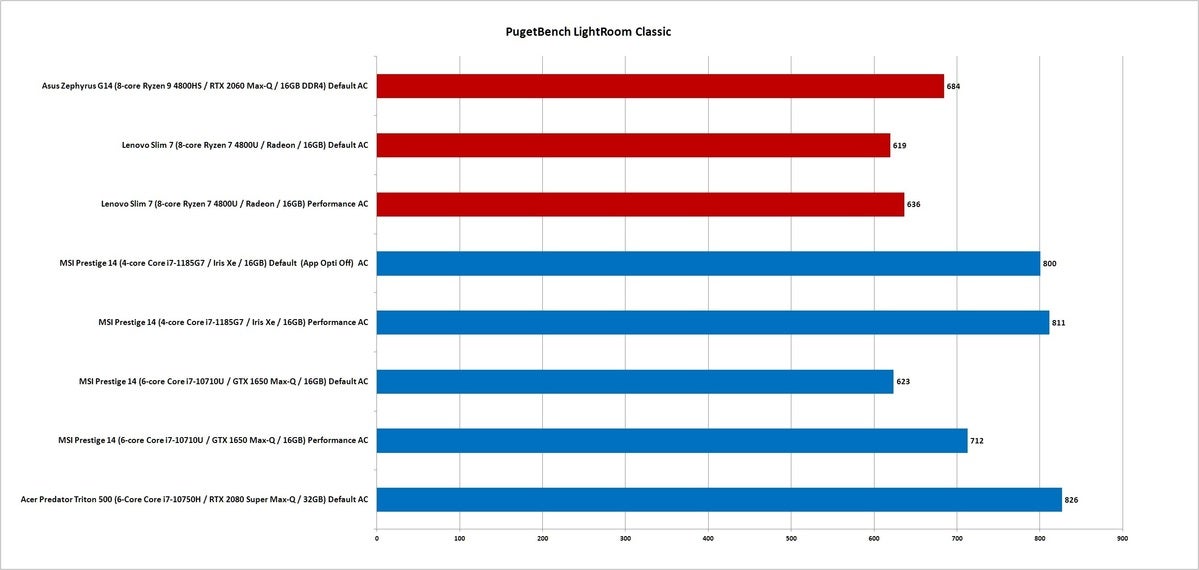 IDG
IDGDiving into the performance that makes up the Lightroom Classic score, we’ll start with how long it takes the app to build a Smart Preview of 500 images, broken out by the different cameras’ RAW types. We thought, “one RAW file is the same as the other,” but apparently not, given the clear differences in results.
Overall, the 11th-gen Tiger Lake-based MSI Prestige 14 Evo and the 10th-gen Intel/ RTX 2080 Super-based Acer Predator Triton 500 are the winners, while the Ryzen-based laptops come in last. Both Ryzen machines also seem to perform worse with the larger Nikon and Sony RAW files, as opposed to the smaller Canon RAW files. Interestingly, the older Comet Lake U/GTX 1650-based MSI Prestige 14 processed the Nikon files slower than the Sony RAW files—something no other laptop in this sample did.
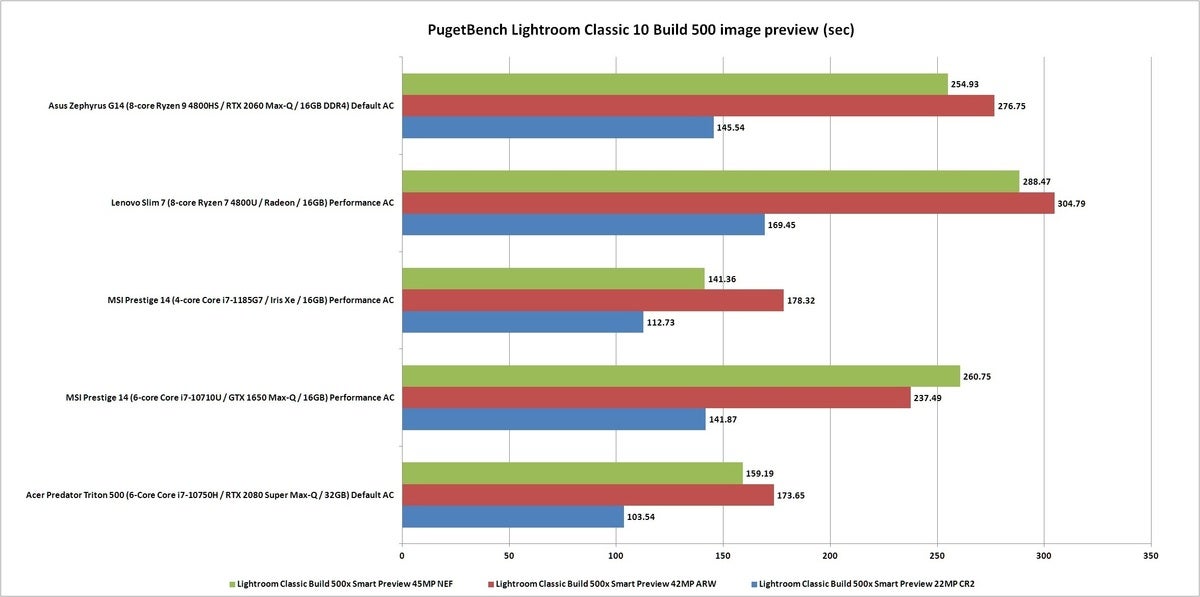 IDG
IDGUp next is how fast the laptops can convert 50 of each different RAW type to Adobe’s digital negative format (DNG). This is done by photographers who want to preserve photos in a high-quality, lossless format that they hope will last longer than the original cameramaker’s format.
The winner here is the bigger and heavier Acer Predator Triton 500, with the 11th-gen Tiger Lake-based MSI Prestige 14 Evo and Asus ROG Zephyrus G14 coming up close. The Lenovo Yoga Slim 7 trails, and in last place, still confusingly, is the older Comet Lake U and GeForce GTX 1650-based MSI Prestige 14. It’s especially slow converting the smaller Canon CR2 RAW files. We think the laptop is simply hitting a thermal road block by the time it gets to the Canon RAW files. It’s either that or some odd problem with the GPU and Lightroom Classic.
Interestingly, the Intel-based laptops all process the Nikon RAW files faster than they do the Sony RAW files. On the AMD side of the fence, the Nikon RAW images take longer than the Sony RAW files.
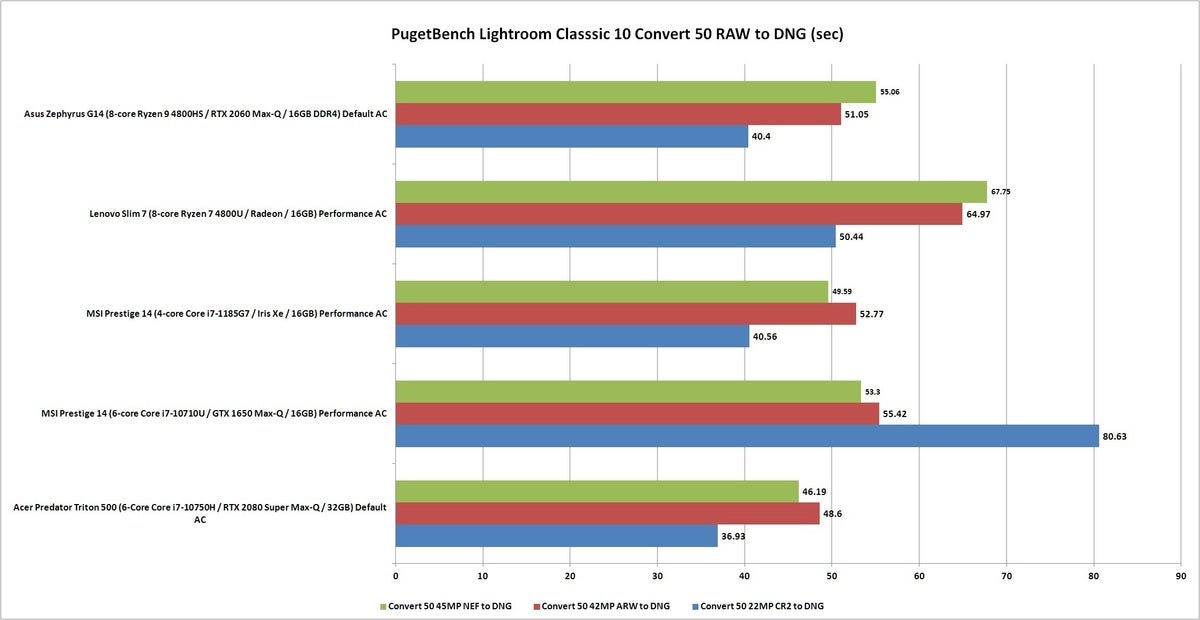 IDG
IDGThe two previous tests tell you how much of a wait you’d suffer when converting or building image previews. The next task gives you a better idea of general responsiveness moving through the app’s interface. Puget Systems considers that an Active Task rather than a Passive Task.
For that, Pugetbench measures the time it takes to hit the right-arrow key and display the next image onscreen in the Develop Module Loupe. We again see the 11th-gen Tiger Lake in the MSI Prestige 14 Evo basically dead even to slightly faster than the Acer Predator Triton 500. The older 10th-gen-based MSI Prestige 14 does well, but it’s clearly a heartbeat behind the other two laptops. Behind the Intel laptops by another beat are both Ryzen-based laptops. We also see that weirdness where the performance dips depending on camera format.
It’s pretty clear to us that Lightroom Classic is better optimized for Canon and Nikon than Sony. Remember: The Nikon D850 images are 45MP, while the A7R III images are 42MP, so it’s not about the megapixels. More likely, Canon and Nikon dominate in professional cameras and therefore enjoy more optimization than Sony does.
 IDG
IDGAnother active task is how long it takes the computers to switch between the Library Module and the Develop Module. Blipping between the modules lets the CPU run up to its top clock speed and then ratchet back down quickly.
The surprise winner is the 11th-gen Tiger Lake chip in the MSI Prestige 14 Evo, which just edges out the larger Acer Predator Triton 500’s 10th-gen H-class CPU. The higher clock speeds or better Adobe optimization put them ahead of both Ryzen 4000 chips. Lightroom Classic is again generally more responsive with Canon and Nikon files over Sony.
 IDG
IDGMoving to a pure processing task, Pugetbench times how long it takes the computer to create a photomerge panorama, using six images in each camera format. We’re not sure what part of Lightroom Classic is GPU-accelerated but the big winner here is Acer’s Predator Triton with its 10th gen Core i7-10750H and GeForce RTX 2080 Super. The older MSI Prestige 14 continues to hit a wall, we suspect because of thermals.
 IDG
IDGOur final Lightroom Classic test exports 150 images from RAW to JPG in each of the three camera formats. The clear winners are again the 11th-gen Tiger Lake chip in the MSI Prestige 14 Evo, and the Acer Predator Triton 500 with its 10th-gen H-class chip. Even the older MSI Prestige 14’s 10th-gen chip and GTX 1650 do reasonably well.
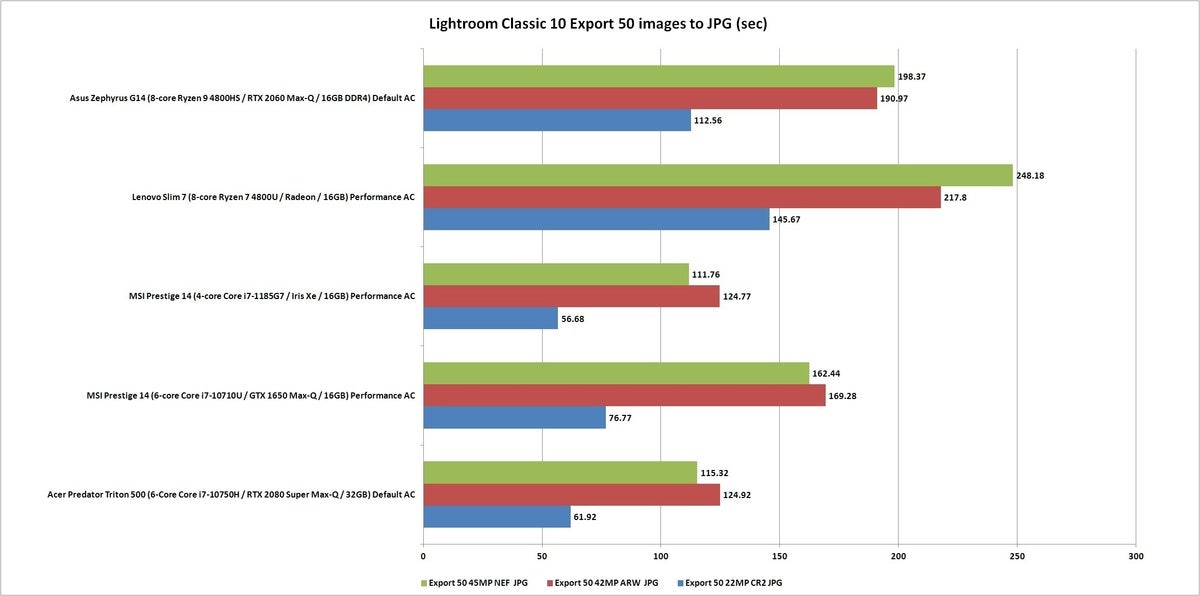 IDG
IDGThis one task in Lightroom Classic slams Ryzen 4000. While we’d forgive fractions of a second, we’re talking about waiting almost two to three times as long. Advantage Intel.
Keep reading for Adobe Premiere in Pugetbench, and our wrap-up conclusions.
Page Break
Pugetbench Adobe Premiere Performance
With this second run at Premiere via Pugetbench, we wanted to see if it corroborated the findings from UL’s Procyon, where the 11th-gen, 4-core Tiger Lake in the MSI Prestige 14 Evo actually bested the 8-core Ryzen 4000 in the Lenovo Yoga Slim 7. We just didn’t expect that 4 cores would beat 8.
As a workstation-tuned test, Pugetbench uses video that aims far higher that what you’ll find in Procyon, including 4K H.264, 4K ProRes 422, and 4K Red footage as part of its standard media. (An extended version uses ProRes 4444 and 8K Red, but that’s richer fare than these laptops can stomach.) Today’s thin-and-light laptops have really come a long way in performance, so Pugetbench is a good ‘stretch’ goal for them.
Read the full public version of the benchmark, or see this screenshot for the overview.
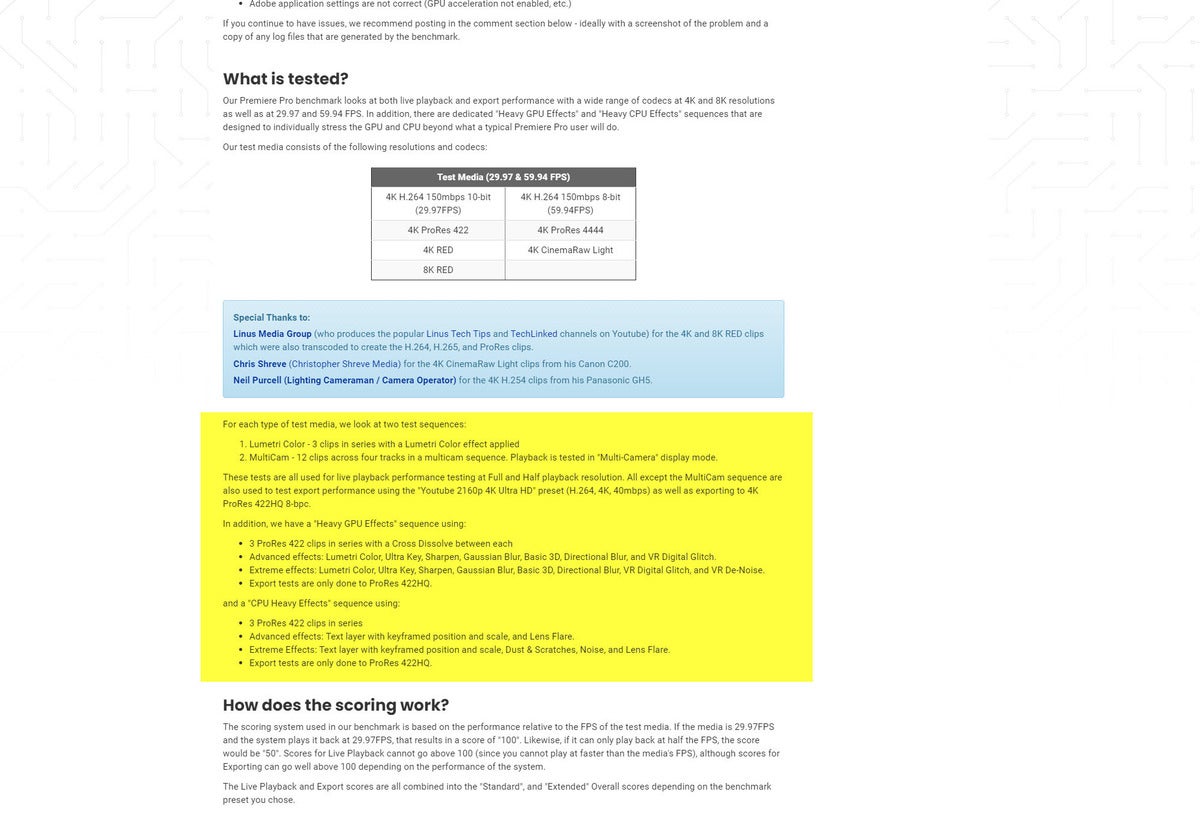 Puget Systems
Puget Systems For the Premiere 14.6 overall score below, a longer bar is better. Kudos to the Asus ROG Zephyrus G14 and its 8-core Ryzen 9 4900HS and GeForce RTX 2060 Max-Q, which muscles past the Acer Predator Triton 500 and its 6-core Core i7-10750H and GeForce RTX 2080 Super Max-Q GPU.
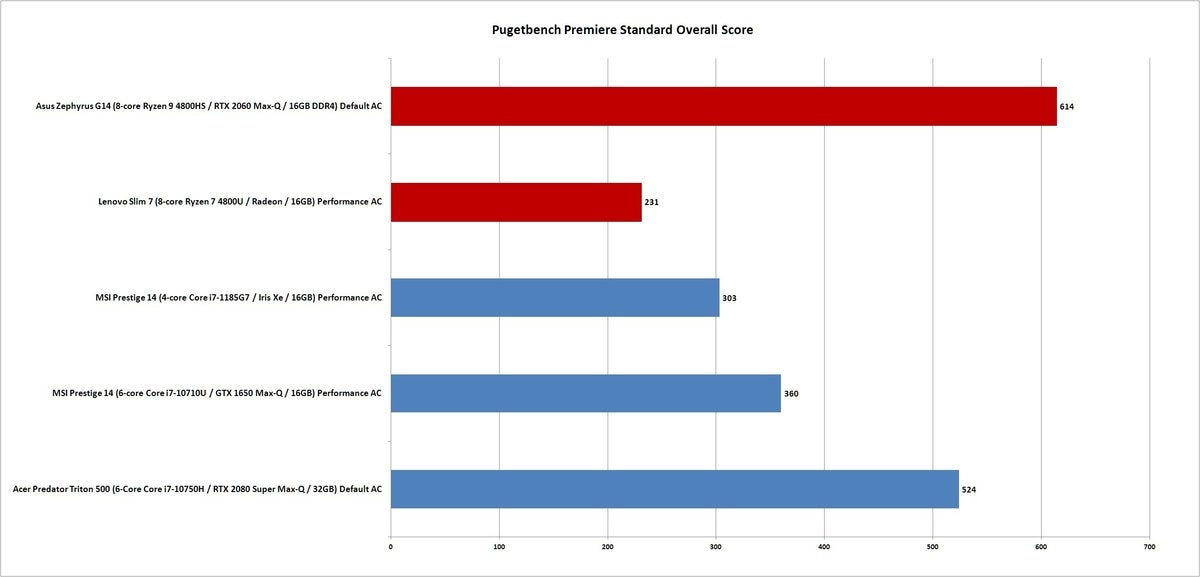 IDG
IDGIn the next chart, to break down just how the laptops performed in the different sections of Pugetbench, we look at the benchmark scores for exporting video (red bar) and for live playback (blue bar) in a four-track Multicam sequence with Lumetri color correction applied. Pugetbench runs the playback tests at full- and half-resolution. The red bars represent the export performance, while the blue represents the playback performance.
We see that laptops with discrete graphics have a pretty huge advantage in export performance. Both the laptops with GeForce RTX GPUs knock it out of the park, while the GeForce GTX 1650 Max-Q in the older MSI Prestige 14 continues to underwhelm.
Playback performance goes to the Asus ROG Zephyrus G14 with its high-end Ryzen chip. All the Intel laptops cluster in the middle, while the Lenovo Yoga Slim 7’s Ryzen 7 4800U comes in last. It even underperforms when compared to the other laptop here without a discrete GPU, the MSI Prestige 14 Evo.
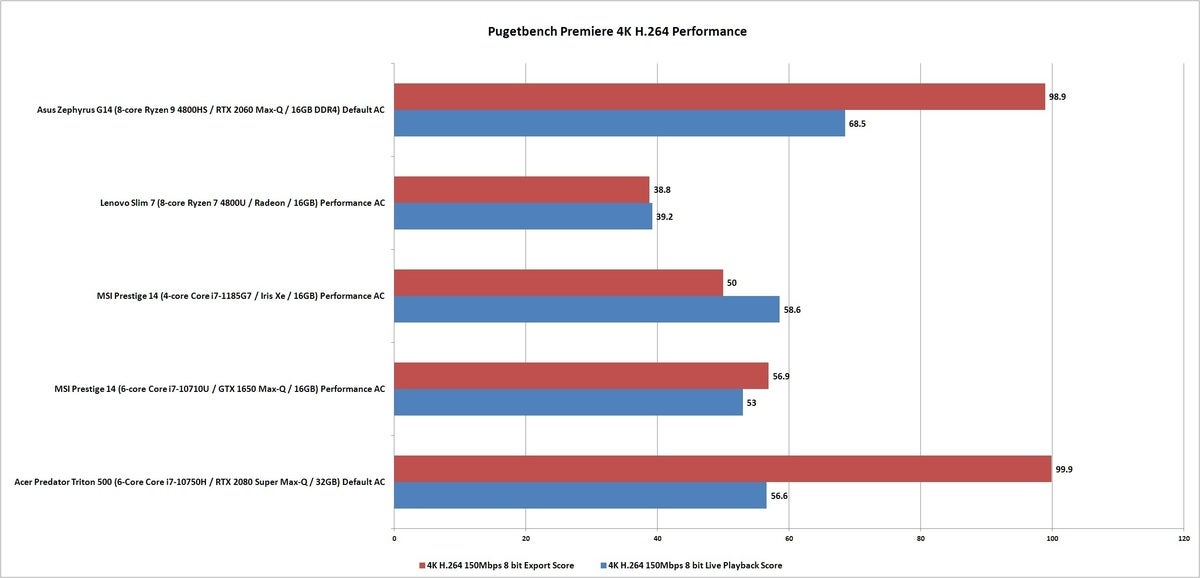 IDG
IDGThe Ryzen 7 4800U in the Lenovo Yoga Slim 7 also stumbles on the 4K Red material. This particular task seems to favor CPU core count along with a decent discrete GPU, finally giving the older MSI Prestige 14 a chance to shine with its 6-core 10th-gen CPU and GTX 1650. The big win goes to the Asus ROG Zephyrus G14, with its 8-core Ryzen 9 4900HS and RTX 2060. While the Acer Predator Triton 500’s RTX 2080 Super is faster in gaming, Premiere doesn’t take advantage of its extra oomph.
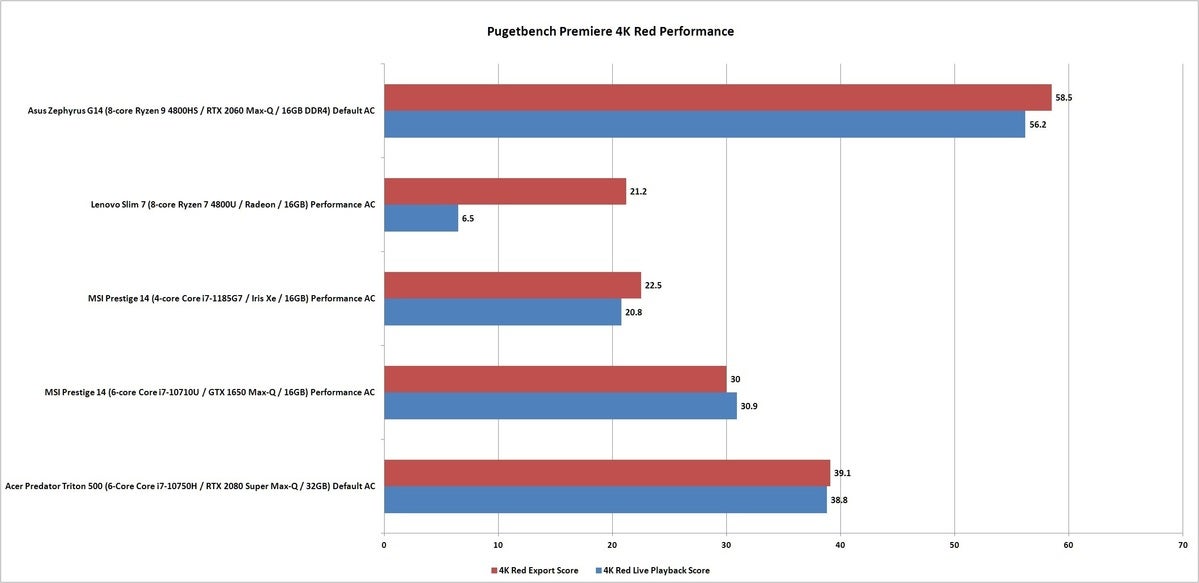 IDG
IDGUp next is the same playback and export task, but using 4K ProRes 422 footage. We see the Lenovo Yoga Slim 7’s Ryzen 7 4800U regain some ground, but it still trails the MSI Prestige 14 Evo’s 11th-gen Tiger Lake.
Interestingly, even though the older MSI Prestige 14 with its 6-core Core i7-10710U and GeForce GTX 1650 chip has been thrashed in Photoshop and Lightroom, it posts an honorable midrange score here.
The overall winner again is the Asus ROG Zephyrus G14 with its Ryzen 9 and RTX 2060.
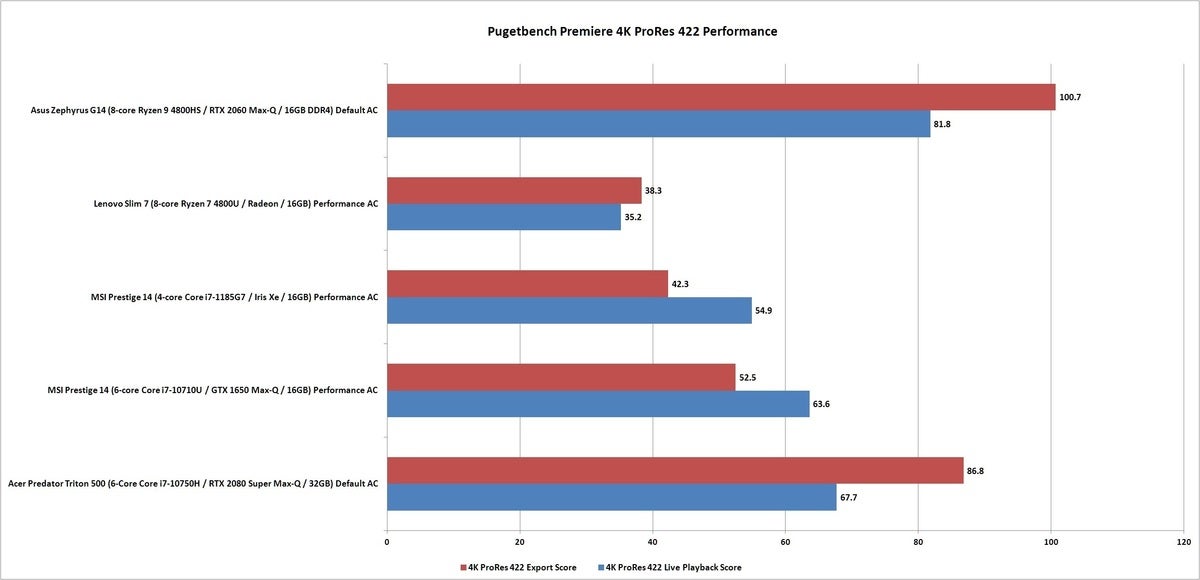 IDG
IDGPugetbench focuses on GPU performance in Premiere by using three ProRes 422 clips with Cross Dissolve, Lumetri Color, Sharpen, Gaussian Blur, Basic 3D, Directional Blur, VR Digital Glitch and other GPU-accelerated effects applied to the video. Performance is based on playback and also export times.
For the video export, the RTX 2080 Super and 10th Core i7-10750H in the Acer Predator Triton 500 naturally win, but the Asus ROG Zephyrus G14’s RTX 2060 and Ryzen 9 4900HS take the upper hand for Live Playback performance. The additional two cores of the Ryzen 9 may be at play here.
While you may have been wondering why MSI’s older Prestige 14 even exists, the laptop finally proves its place by outpacing the newer Prestige 14 and Lenovo Yoga Slim 7 in both export times and playback. While we’re comparing discrete and integrated graphics here, arguably unfairly, all three laptops weigh about the same. The GPU matters, folks.
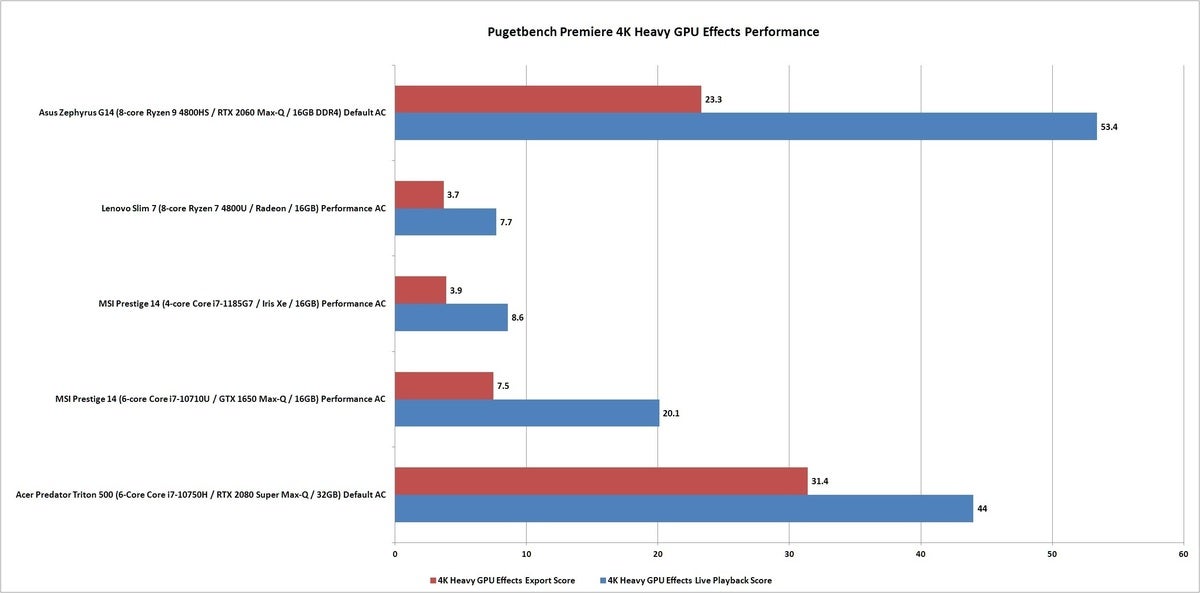 IDG
IDGOur final Premiere test result is Pugetbench’s CPU Heavy Effects test, which uses three ProRes 4222 files with a text layer in key-framed positions and JJ Abrams’ Lens Flare effect. The test also applies Dust & Scratches and Noise.
The winner again is the core-heavy Asus ROG Zephyrus G14. While the Acer Predator Triton 500 does quite well in playback performance, the export result isn’t that much faster than that of the Lenovo Yoga Slim 7. The latter finally ekes out victory in export over the MSI Prestige 14 Evo’s Tiger Lake chip, but the Intel box bites back in playback performance.
 IDG
IDGAdobe Laptop Performance Conclusion
The right laptop will always depend on what you’re doing, but our benchmarks show some clear trends. Having a decently fast GPU helps in Photoshop and in Premiere. Photoshop also tends to favor high-clock-speed CPUs. All that suggests that an 11th-gen Tiger Lake CPU paired with a GeForce GTX or RTX GPU might be the ultimate configuration...for Photoshop.
While all of the laptops performed well in Adobe Lightroom Classic, the edge leans once again toward Intel’s 11th-gen Tiger Lake in the MSI Prestige 14 Evo. The 10th-gen Core i7-10750H in the Acer Predator Triton 500 isn’t too shabby either, but it is a larger and heavier laptop.
AMD has its moments, especially in heavy tasks in Premiere, where the 8-core Ryzen 9 4900HS and RTX 2060 in the Asus ROG Zephyrus G14 lead the way. The surprise was how well the 4-core Core i7-1185G7 in the MSI Prestige 14 Evo performed against the 8-core Ryzen 7 4800U in the Lenovo Yoga Slim 7. Because both laptops lack discrete graphics the test results don’t show the full picture, but the trend remains strong: Intel's Core i7-1185G7 Tiger Lake CPU performs best in the most test situations.





